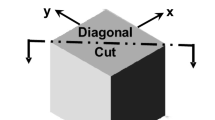Abstract
Macroscopic traits of solidification such as thermal gradient, solidification rate, and other criteria functions were extracted from computer modeling data of a single-crystal, investment-cast superalloy. The thermal histories were used to predict the presence or absence of grain defects in the shaped castings. Freckle defects were found on castings with various processing parameters, even though the traditional microstructural defect map predicted no freckles and a consistent microstructure. The findings suggest that the traditional defect map criteria are insufficient to accurately describe the formation of these and other single-crystal grain defects. Hence, additional criteria for porosity formation and other phenomena were investigated and found to be sensitive to changes in solidification conditions and grain defect formation. The additional functions were found to be necessary to fully capture the total energy of all solidification phenomena. When these functions are used in conjunction with the traits of the microstructural defect map, the prediction of defects in single-crystal castings can more accurately describe solidification under the stringent requirements of single-crystal turbine components.
Similar content being viewed by others
References
K.O. Yu et al., “Solidification Modeling of Single Crystal Investment Castings,” AFS Transactions, 97 (1990), pp. 417–428.
Manufacturing Technology for Advanced Propulsion Materials WL-TR-91-8047, vol. 1, Phase IX, Advanced Turbine Airfoil Casting Technology, Task 2: Casting Simulation, Wright Laboratories, Air Force Systems Command, Wright-Patterson Air Force Base (February 1992).
J.S. Tu and R.K. Foran, “The Application of Defect Maps in the Process Modeling of Single-Crystal Investment Casting,” JOM, 44(6) (1992), pp. 26–28.
K.O. Yu et al., “Solidification Modeling of Complex-Shaped Single Crystal Turbine Airfoils,” Superalloys 1992, ed. S. Antolovich et al. (Warrendale, PA: TMS, 1992), pp. 135–144.
S.M. Copely et al., “The Origin of Freckles in Unidirectionally Solidified Castings,” Metallurgical Transactions, 1 (1970), pp. 2193–2204.
A. Giamei, “Solidification Process Modeling: Status and Barriers,” JOM, 45(1) (January 1993), pp. 51–53.
T. Imwikelried et al., “Modeling of Dendritic Single Crystal Solidification at the Macro- and Microscopic Levels: Application to Turbine Blades,” Modeling of Casting, Welding and Advanced Solidification Processes VI, ed. T. Piwonka et al. (Warrendale, PA: TMS, 1993), pp. 63–70.
R.M. Pillai et al., “Critical Temperature for Evaluation of Thermal Parameters,” AFS Transactions, 80 (1978), pp. 221–226.
P.N. Hansen et al., “How to Select and Use Criterion Functions in Solidification Simulation,” AFS Transactions, 95 (in press).
Author information
Authors and Affiliations
Rights and permissions
About this article
Cite this article
Purvis, A.L., Hanslits, C.R. & Diehm, R.S. Modeling characteristics for solidification in single-crystal, investment-cast superalloys. JOM 46, 38–41 (1994). https://doi.org/10.1007/BF03222535
Issue Date:
DOI: https://doi.org/10.1007/BF03222535




